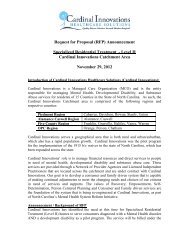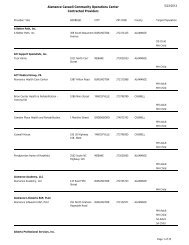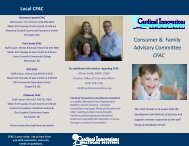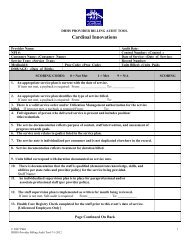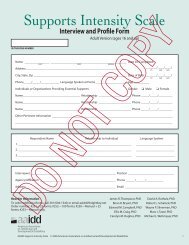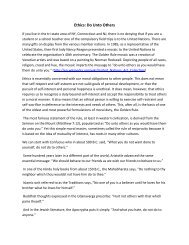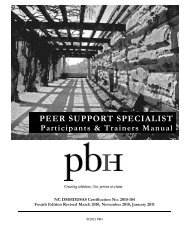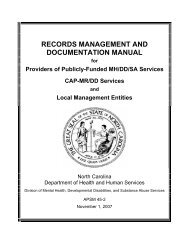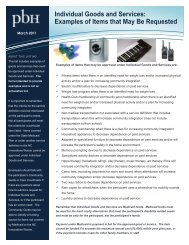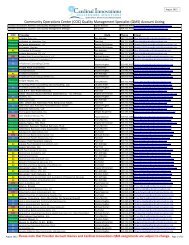Supports Intensity Scale for Children Field Test Version 1.1 ...
Supports Intensity Scale for Children Field Test Version 1.1 ...
Supports Intensity Scale for Children Field Test Version 1.1 ...
Create successful ePaper yourself
Turn your PDF publications into a flip-book with our unique Google optimized e-Paper software.
SIS <strong>for</strong> <strong>Children</strong> Page 1 of 22<strong>Supports</strong> <strong>Intensity</strong> <strong>Scale</strong> <strong>for</strong> <strong>Children</strong><strong>Field</strong> <strong>Test</strong> <strong>Version</strong> <strong>1.1</strong>American Association on Intellectual and Developmental DisabilitiesJuly 6, 2009James R. Thompson - Illinois State UniversityMichael Wehmeyer - University of KansasSusan R. Copeland - University of New MexicoCarolyn Hughes – Vanderbilt UniversityTodd D. Little - University of KansasShea Obremski - University of KansasJames R. Patton - University of TexasEd Polloway - Lynchburg CollegeRodney E. Realon - North Carolina Mental Health, Developmental Disabilities and Substance Abuse ServicesRobert Schalock – Schalock ConsultantsDebbie Shelden – Illinois State UniversityMarc J. Tassé – University of South FloridaCopyright © 2008 American Association on Intellectual Disabilities, Washington DC, USA
SIS <strong>for</strong> <strong>Children</strong> Page 3 of 22participation) of the child in an activity. In other words, successful engagement entails a level of per<strong>for</strong>mance/involvement/participation in an activitythat is comparable to that of typically functioning peers without disabilities.• Each item makes an assumption that the child has the opportunity to participate at levels potentially requiring maximum frequency, time, and type ofsupport. There<strong>for</strong>e, respondents should remember that ratings can reflect this maximum level of potential activity.GUIDE TO RATING ITEMS IN PART 1 – EXCEPTIONAL MEDICAL AND BEHAVIORAL SUPPORT NEEDSSpecial medical and behavioral concerns are identified in this section of scale. It is assumed that certain medical conditions and challenging behaviors candictate that a child will require substantial levels of support, regardless of his or her relative intensity of support needs in other life areas assessed in Part 2 -Support Needs <strong>Scale</strong>. For example, children who have significant support needs due to ostomy care are likely to need significant levels of support in theirdaily life, regardless of their needs in the areas of home living, school learning, etc. Using the 3-point Likert rating scale (0 = no support needed; 1 = somesupport needed; 2 = extensive support needed), the interviewer assesses the individual’s intensity of support need <strong>for</strong> each medical and behavioral item.Exceptional Medical NeedsThe critical question to answer when completing the medical items is “What is the significance of the following medical conditions <strong>for</strong> this child in regardto extra support required?”Rating options are:0 = No Support Needed;1 = Some Support Needed (i.e., providing monitoring and/or occasional assistance);2 = Extensive Support Needed (i.e., providing regular assistance to manage the medical condition or behavior).If the child does not have the condition, score the item “0” <strong>for</strong> No Support Needed. If the child has the condition and some extra support is required (e.g.,perhaps a small amount of time each day is devoted to monitoring or otherwise managing the condition, and people who support the individual must becognizant continuously of the condition in order to assure the individual’s health and safety), then score the item a “1” <strong>for</strong> Some Support Needed. If the childhas the condition and significant extra support is required (e.g., perhaps several hours a day are devoted to managing the condition, and the condition posesan important health and safety risk <strong>for</strong> the individual), then score the item a “2” <strong>for</strong> Extensive Support Needed. There is definitely a gray area between the“some” and “extensive” support needed. This is inherent in quantifying (i.e., applying a specific number) a construct such as support needs. Support needswill vary along a continuum; that is, there are in actuality fine gradations in the intensities of needs <strong>for</strong> different individuals. In cases that seem to fallbetween “some support needed” and “extensive support needed,” respondents are encouraged to use their best judgment and whenever possible consult withadditional respondents.Exceptional Behavioral NeedsThe critical question to answer when completing the behavioral items is “What is the significance of the following challenging behaviors <strong>for</strong> this child inregard to extra support required?”Copyright © 2008 American Association on Intellectual Disabilities, Washington DC, USA
Rating options are:SIS <strong>for</strong> <strong>Children</strong> Page 4 of 220 = No Support Needed;1 = Some Support Needed (i.e., providing monitoring and/or occasional assistance);2 = Extensive Support Needed (i.e., providing regular assistance to manage the medical condition or behavior).If the behavior is not an issue and the child does not display the behavior, then score the item “0” <strong>for</strong> No Support Needed. If the child displays the behaviorand some extra support is required (e.g., perhaps a small amount of time each day is devoted to monitoring or otherwise managing the behavior and thosewho interact with the individual must be continuously aware of the behavior in order to assure the health and safety of the individual as well as others in thechild’s presence), then score the item “1” <strong>for</strong> Some Support Needed. If the child displays the behavior and significant extra support is required (e.g., perhapsseveral hours a day are devoted to monitoring or otherwise managing the behavior, and the behavior poses an important health and safety risk <strong>for</strong> theindividual or others in the environment), then score the item “2” <strong>for</strong> Extensive Support Need.As with exceptional medical needs, distinguishing between “some” and “extensive” support can be difficult. When attempting to determine whether an itemshould be scored a “1” or a “2” <strong>for</strong> borderline cases, the interviewer may want to consider the severity of the consequences of the behavior. For example, if“property destruction” were a concern, it would be important to consider how much damage the child could actually do if the behavior were to occur in theworst case scenario and how life threatening the property destruction could be. A child who had engaged in destroying an entire room (e.g., break furniture,smash a television) would pose a more serious risk than a child who is likely to destroy only objects such as toys. It would also be considered moredangerous if the child typically engaged in breaking windows with his fist versus punching seat cushions on a couch. It would be best to score the item as a“2” if there is a real risk that the behavior could have very significant consequences (e.g., health hazard, violation of the law). However, if the behavior (inan extreme instance) is likely to have less intensive consequences, it would be best to score the item a “1”.Review of Key Guidelines <strong>for</strong> Part 1 – Exceptional Medical and Behavioral Needs• Rate all items; if an item is not an issue <strong>for</strong> a child, rate it as a “0”• When distinguishing between “some” (rating of 1) and “extensive” (rating of 2) support, consider (a) consulting with additional individuals to getadditional input, (b) the time involved in providing supports, and (c) the consequences of either the behavior or medical condition (Is the child likelyto become seriously ill? Does the challenging behavior have the potential to threaten the health and safety of the child or others?).• If a child experiences one or more medical conditions or challenging behaviors that are not on the list in Part 1 – Exceptional Medical andBehavioral Needs, it is essential to list these under the “other” category. Items listed under “other” carry the same weight and influence as thoseidentified in the scales.Copyright © 2008 American Association on Intellectual Disabilities, Washington DC, USA
GUIDE TO RATING ITEMS FOR PART 2: SUPPORTS NEED SCALESIS <strong>for</strong> <strong>Children</strong> Page 5 of 22Items in Part 2 – Support Needs <strong>Scale</strong>, are rated across three dimension of support intensity: Frequency (how often is extraordinary support needed?), Time(how much time by another human being is needed to provide extraordinary support), and Type (what is the nature of the extraordinary support that isprovided?).Rating TYPEWhen rating Type of Support, the respondent should focus on the following:If a child were to engage in the activity on a regular basis over the next several months, what would be the nature of the extraordinary support (i.e.,assistance that most typically functioning peers would not need) that others would need to provide to enable the individual to be successful in theactivity. This dimension of support is concerned with identifying the characteristics of the support that is provided by others. Although differenttypes of support are needed <strong>for</strong> any activity (e.g., verbal prompting and partial physical assistance may both be involved), the respondent is asked toidentify which type of support best characterizes or most dominates the assistance that is provided.Rating options are:0=none1=monitoring2=verbal/gestural prompting3=partial physical assistance4=full physical assistanceRating FREQUENCYWhen rating FREQUENCY, the respondent should focus on answering the following question:If this child were to engage in this activity on a regular basis over the next several months, how often would he/she would require someone (teacher,residential staff, teacher’s aid, peer, community volunteer) to provide support to him/her that most typically functioning children of the same age wouldnot need?This dimension of support is concerned with identifying how often extra support needs to be provided by others. This dimension of support is NOTconcerned with how often the child actually engages in an activity. There are many good reasons why a child may or may not choose to participate in anactivity on a regular basis. However, <strong>for</strong> purposes of completing the SIS-<strong>Children</strong>, the scoring must be based on the support necessary if the child wereto engage in the activity on a regular basis over the next several months.Copyright © 2008 American Association on Intellectual Disabilities, Washington DC, USA
SIS <strong>for</strong> <strong>Children</strong> Page 6 of 22Rating options are:0 = Negligible; the child’s support needs are rarely if ever different than same-aged peers in regard to frequency.1 = Infrequently; the child will occasionally need someone to provide extraordinary support to him/her that same-aged peers will not need, but on mostoccasions will not need any extra support.2 = Frequently; in order <strong>for</strong> the child to participate in the activity, extra support will need to be provided <strong>for</strong> about half of the occurrences of the activity.3 = Very Frequently; in most occurrences of the activity the child will need extra support that same aged peers will not need; only occasionally will thechild not require any extra support.4 = Always; on every occasion that the child participates in the activity, the child will need extra support that peers of the same chronological age willnot needRating Amount of DAILY SUPPORT TIME (DST)When rating Amount of Daily Support Time (DST), the respondent should focus on answering the following question:If this child were to engage in the activity on a regular basis over the next several months - during the course of a typical day (24 hours), how much totaldaily time would be needed to provide extraordinary supports (i.e., types of assistance that most typically functioning children would not need) to enablethe individual to be successful in the activity? This “extra time” might be needed very regularly (e.g., every day) or it might be needed more episodically(e.g., once every two weeks). However, it is of vital importance <strong>for</strong> interviewers to understand that this dimension does not take frequency into account.Rather, the focus is on the total daily time that is needed to provide extraordinary supports (i.e., types of assistance that most typically functioningchildren would not need) on the days when the support is needed.This rating estimates the amount of time needed to provide the support across a TYPICAL day when the support is needed. A day is defined as24 hours. Thus, whether the support is needed everyday or very infrequently, on a typical day when the support is needed – during that 24-hour cycle –how much total, cumulative time needs to be devoted to providing the support?Rating options are:0=none.1=less than 30 minutes2=30 minutes to less than 2 hours3=2 hours to less than 4 hours4=4 hours or moreGUIDELINES WHEN DETERMINING RATINGS IN PART 2 – SUPPORT NEEDS SCALEA. Consider Multiple Tasks Within An Activity.If the activity contains multiple elements, then greater emphasis should be placed on the essential element(s) that are at the heart of the activitywhen determining ratings; however, the secondary elements should also be considered. The task <strong>for</strong> respondents is to provide a rating that reflects theirperception of a valid composite rating of primary and secondary elements. For example, Item #3 (Keeping self clean and properly groomed) of Part 2 -Section A (Home Living Activities) includes bathing, washing hands, keeping oneself clean during meals and snacks, combing hair, brushing teeth, and inCopyright © 2008 American Association on Intellectual Disabilities, Washington DC, USA
SIS <strong>for</strong> <strong>Children</strong> Page 7 of 22general maintaining a kempt appearance (based on age expectations – standards of appearance <strong>for</strong> a 6 year old are different than standards <strong>for</strong> a 15 year old).An example <strong>for</strong> applying these guidelines to the three ratings is provided below:• If the child requires only verbal/gestural prompting to do the essential element of bathing, but needs partial physical assistance <strong>for</strong> maintaining akempt appearance, and full physical assistance <strong>for</strong> combing hair, then a type of support rating of “3” (partial physical assistance) is justified. In thisexample, enough physical assistance is needed to complete the activity of “Keeping self clean and properly groomed” on a regular basis to justify acomposite rating of “3- partial physical assistance” <strong>for</strong> “type of support”.• If the child only occasionally needed extraordinary support that same aged peers would not need <strong>for</strong> the essential element of bathing (i.e., <strong>for</strong> mostbaths the child did not need any extraordinary support), and also only occasionally needed extra support <strong>for</strong> the secondary elements of the activity,then a Frequency rating of “1” would be the accurate rating; 1 = Infrequently; the child will occasionally need someone to provide extraordinarysupport to him/her that same-aged peers will not need, but on most occasions will not need any extra support. To justify the higher rating of “2”,extra support will need to be provided <strong>for</strong> about half of the occurrences of the activity.• If approximately 30 minutes of daily support time was required <strong>for</strong> the essential element of “bathing” on a typical day that the individual took a bathor shower and regular assistance was needed <strong>for</strong> washing hands, keeping oneself clean during meals and snacks, combing hair, brushing teeth,maintaining a kempt appearance, etc., requiring at least an additional 60 minutes a day, then the typical daily support time would be 90 minutes.There<strong>for</strong>e, a DST rating of “2” (30 minutes to less than 2 hours) would be the correct rating that best reflects daily support time in its entirety. In thisexample, the bathing is a relatively quick process and there is not enough extra time required on a daily basis to complete the secondary tasks tojustify a higher composite rating of “3” (2 hours but less than 4 hours).B. Assess the Individual’s Support Needs Holistically.The individual’s skill level, use of assistive technology, motivation, health, behavior, and safety/vulnerability must all be considered whendetermining ratings. People should be rated in accordance with their current status and functioning. Rate children exactly the way they are today.If an individual uses assistive technology, the person should be rated with said technology in place. That is, it is important to factor in the assistivetechnology that the person uses on a regular basis when making the ratings. However, ratings should not be based on the intensity of support a person mightrequire if their use of assistive technology might change in the future. If assistive technology is not yet used or is not yet available to the person, it shouldnot be considered when completing the SIS. For example, an individual might need less support in “Participating in activities in common school areas (e.g.,playground, hallways, cafeteria)” if he had access to a motorized wheelchair. However, because this person does not have access to a motorized wheelchair,ratings on the SIS should reflect the reality of his situation and the support he needs due to (a) his disabilities and (b) the lack of appropriate AT. In manycases, the intensity of an individual’s support needs will decrease when provided with appropriate AT.C. Base Ratings on School and Community Environments.Ratings should be referenced to settings (i.e., school, home, community) used by the general population. For example, ratings such as those relatedto school should be based on schooling in general education settings. This is not to say that a planning team must conclude the least restrictive educationsetting <strong>for</strong> each child is always the general education classroom when developing an IEP. However, ratings on the <strong>Children</strong>’s SIS should always be based ongeneral education settings not on specialized environments.D. Do Not Consider Services and <strong>Supports</strong> the Person is Currently Receiving.Copyright © 2008 American Association on Intellectual Disabilities, Washington DC, USA
SIS <strong>for</strong> <strong>Children</strong> Page 8 of 22Ratings should be made <strong>for</strong> each activity without regard to the services or supports currently provided by other people. Moreover, ratings should notbe altered because of the availability of natural supports. That is, in instances where a neighborhood friend provides extraordinary support to an individualchild (e.g., the friend helps the child identify which school bus to board at the end of the school day), the child should still be rated as needing theextraordinary support.E. Pay Close Attention to the Verb Used in the Item Stem.The rating should consider the action verb that is used in the stem of the activity, since some verbs may reflect a greater level of activity andthere<strong>for</strong>e more support. For example, getting to school includes transportation, whereas participating in test taking and evaluation activities assumes thatone is already there. Keeping track of personal belongings involves the use of money and potential vulnerability issues. Interacting with friends, family andcommunity members is not as complex of an activity as is making and keeping friends.Review of Key Guidelines <strong>for</strong> Part 2 – Support Needs <strong>Scale</strong>• Consider multiple tasks within an activity• Assess a child’s support needs holistically• Base ratings on settings used by the general population (e.g., items related to classroom learning activities should be considered in regard togeneral education classrooms, not special class settings)• Do not consider services or supports the child is currently receiving• Pay close attention to the verb used in the item stemTHANK YOU FOR PARTICIPATING IN THIS FIELD TESTCopyright © 2008 American Association on Intellectual Disabilities, Washington DC, USA
<strong>Children</strong>’s SIS: Demographic In<strong>for</strong>mation:Part A. In<strong>for</strong>mation about the interviewerSIS <strong>for</strong> <strong>Children</strong> Page 9 of 22Name: ___________________ Agency/School: _____________________City, State: ____________________________Gender: Male Female Education: HS Diploma 2-yr. degree BS/BA Master’s Degree Doctoral DegreeEthnic Background: White – Non-Hispanic Black – Non-Hispanic Asian/Pacific Islander Native People Hispanic Multiple ethnic backgrounds Other (specify _________________________ )Years of Work Experience in Services to <strong>Children</strong> or Youth with Disabilities: ______________ yearsCurrent Workplace Location: Urban/suburban RuralInterviewer relationship to child: ___________________________ number of years known child: _______Part B. In<strong>for</strong>mation about the respondentsRespondent #1: relationship to child: _______________________ number of years known child: _______Respondent #2: relationship to child: _______________________ number of years known child: _______Part C. In<strong>for</strong>mation about the child being ratedGender: Male Female Age: _____ years, _____ monthsIQ Level:
Section II. Estimates of Support NeedsSIS <strong>for</strong> <strong>Children</strong> Page 10 of 22Instructions: Interviewers, Please read the name and description of each support domain, and request that each respondent rate the child’s support needs on ascale of 1 to 5 using the following criteria. Please stress that ratings should be made in relation to typically functioning children of the same age.Respondent #1:Noextra supportneededMediumsupportneededTotalsupportneeded1 2 3 4 5Home LivingActivitiesActivitiescompleted as afunction of living ina householdCommunity &NeighborhoodActivitiesActivitiescompleted as afunction of beinga member of acommunity orneighborhoodSchoolParticipationActivitiesActivitiesassociated withparticipating inthe schoolcommunitySchoolLearningActivitiesActivitiesassociated withacquiringknowledgeand/or skillswhile attendingschoolHealth andSafetyActivitiesActivities thatassure safetyand healthacross home,school, andcommunityenvironments.SocialActivitiesActivities thatpertain tosocialintegrationwith others,both childrenand adults.AdvocacyActivitiesActivitiesrelated toacting as acausal agent inone's life,making choicesand decisions,and availingoneself ofleadershipopportunities.1 2 3 4 51 2 3 4 51 2 3 4 51 2 3 4 51 2 3 4 51 2 3 4 51 2 3 4 5Respondent #1: Rate the child’s overall support needs by circling the appropriate number (1-5) relative to other childrenthe same ageNoextra supportneededMediumsupportneededTotalsupportneeded1 2 3 4 5Copyright © 2008 American Association on Intellectual Disabilities, Washington DC, USA
SIS <strong>for</strong> <strong>Children</strong> Page 11 of 22Respondent #2:Home LivingActivitiesActivitiescompleted as afunction of living ina householdCommunity &NeighborhoodActivitiesActivitiescompleted as afunction of beinga member of acommunity orneighborhoodSchoolParticipationActivitiesActivitiesassociated withparticipating inthe schoolcommunitySchoolLearningActivitiesActivitiesassociated withacquiringknowledgeand/or skillswhile attendingschoolHealth andSafetyActivitiesActivities thatassure safetyand healthacross home,school, andcommunityenvironments.SocialActivitiesActivities thatpertain tosocialintegrationwith others,both childrenand adults.AdvocacyActivitiesActivitiesrelated toacting as acausal agent inone's life,making choicesand decisions,and availingoneself ofleadershipopportunities.1 2 3 4 51 2 3 4 51 2 3 4 51 2 3 4 51 2 3 4 51 2 3 4 51 2 3 4 5Respondent #2: Rate the child’s overall support needs by circling the appropriate number (1-5) relative to other childrenthe same ageNoextra supportneededMediumsupportneededTotalsupportneeded1 2 3 4 5Copyright © 2008 American Association on Intellectual Disabilities, Washington DC, USA
PART I: EXCEPTIONAL MEDICAL AND BEHAVIORAL NEEDS(Item descriptions on following pages)SIS <strong>for</strong> <strong>Children</strong> Page 12 of 220 = No Support Needed;1 = Some Support Needed (i.e., providing monitoring and/or occasional assistance);2 = Extensive Support Needed (i.e., providing regular assistance to manage the medical condition or behavior).MEDICAL BEHAVIORALRespiratory care Externally-directed destructivenessInhalation or oxygen therapy 0 1 2 Prevention of assaults or injuries to others 0 1 2Postural drainage 0 1 2Prevention of property destruction0 1 2Chest PT 0 1 2(e.g., fire setting, breaking furniture)Suctioning 0 1 2 Prevention of stealing 0 1 2Feeding assistance Self-directed destructivenessOral stimulation or jaw positioning 0 1 2 Prevention of self-injury 0 1 2Tube feeding (e.g., nasogastric) 0 1 2Prevention of pica (ingestion of inedible 0 1 2Parenteral feeding (e.g., IV) 0 1 2substances)Skin care Prevention of suicide attempts 0 1 2Turning or positioning 0 1 2 SexualDressing of open wound(s) 0 1 2 Prevention of sexual aggression 0 1 2Other exceptional medical care Prevention of non-aggressive but0 1 2inappropriate sexual behaviorProtection from infectious diseases due 0 1 2 Other exceptional behavioral concernsto immune system impairmentSeizure management 0 1 2 Prevention of tantrums or emotional0 1 2outburstsDialysis 0 1 2 Prevention of wandering 0 1 2Ostomy care 0 1 2 Prevention of substance abuse 0 1 2Lifting and/or transferring 0 1 2 Maintaining mental health treatments 0 1 2Eating Disorders 0 1 2 Prevention of Truancy 0 1 2Therapy Services 0 1 2 Other(s) – List all that applyAllergies 0 1 2Diabetes Management 0 1 2Other(s) – List all that apply_______________________________012_________________________012_______________________________012_________________________012_______________________________012Copyright © 2008 American Association on Intellectual Disabilities, Washington DC, USA
Item Descriptions <strong>for</strong> Exceptional Medical and Behavioral Support NeedsSIS <strong>for</strong> <strong>Children</strong> Page 13 of 22Descriptions of Exceptional Medical Needs Descriptions of Exceptional Behavioral NeedsItem Description Item DescriptionRespiratory care Externally-directed destructivenessInhalation or oxygen therapy Uses of a nebulizer or oxygen Prevention of assaults orinjuries to othersHits, punchs, kicks, bits orintentionally harms othersPostural drainageNeeds positioning to help drainsecretions/mucus in the lungsPrevention of propertydestructionBreaks windows, damages furniture,sets fires, defaces property, etc.Chest PTNeeds chest physical therapy to helpwith drainage of secretionsPrevention of stealing Steals/takes other people’s property,shoplifts, etc.Suctioning Needs suctioning of secretions Self-directed destructivenessFeeding assistance Prevention of self-injury Engages in head banging, eye gouging,skin picking, cutting, etc.Oral stimulation or jawpositioningNeeds physical assistance or oralstimulation to help with feedingPrevention of pica(ingestion of inediblesubstances)Eats cigarette butts, paper, or otherobjectsTube feeding (e.g.,nasogastric)Uses a nasogastric or gastrostomytube <strong>for</strong> feedingPrevention of suicideattemptsAttempts to hurt oneself with theintention of suicideParenteral feeding (e.g., IV) Uses an intravenous tube <strong>for</strong> feeding SexualSkin care Prevention of sexualaggressionEngages in pedophilia, sexual assault,etc.Turning or positioning Needs assistance with repositioningor turning in chair or bed to preventsoresPrevention of nonaggressivebutinappropriate behaviorMasturbates in public places,exhibitionismDressing of open wound(s)Needs assistance with the cleaningand dressing of open soresItem Descriptions <strong>for</strong> Exceptional Medical and Behavioral Support Needs Continue on Next PageCopyright © 2008 American Association on Intellectual Disabilities, Washington DC, USA
Descriptions of Exceptional Medical Needs Descriptions of Exceptional Behavioral NeedsSIS <strong>for</strong> <strong>Children</strong> Page 14 of 22Item Description Item DescriptionProtection from infectiousdiseases due to immune systemimpairmentSeizure managementOther exceptional medical care Other exceptional behavioral concernsRequires universal precautions toprevent infections due to weakenedimmunity system or infectious diseaseNeeds medication and seizurePrevention of tantrums oremotional outburstsPrevention of wanderingprecautions and managementDialysis Uses peritoneal or hemodialysis Prevention of substanceabuseOstomy care Needs colostomy care Maintaining mental healthtreatmentsLifting and/or transferringEating disordersTherapy servicesAllergiesDiabetes ManagementOther(s) – List all that applyNeeds assistance <strong>for</strong> lifting andtransferring to and from chair, bed, etc.Needs assistance to manage eating,including the refusal to eatNeeds occupational therapy,psychological therapy, speech-languagetherapy, individual or grouppsychotherapyNeeds assistance to avoid triggers <strong>for</strong>allergic reactions, and managing allergicreactions (e.g., epi-pen)Needs assistance managing childhooddiabetesShould include a listing of anyexceptional medical needs that are notaccounted <strong>for</strong> in the previous itemsPrevention of TruancyOther(s) – List all that applyScreams, curses, throws objects,threatens violenceRuns away, wanders off – risk ofgetting lost or potentially injuredEngages in excessive consumptionof alcohol, misuses prescriptionmedication, uses illegal drugs orother toxic substances (e.g., sniffingglue, paint)Includes taking psychotropicmedication, attending appointments,and complying with treatmentPrevention of missing school <strong>for</strong>reasons other than health or familydeathShould include a listing of anybehavioral concerns that are notaccounted <strong>for</strong> in the previous itemsCopyright © 2008 American Association on Intellectual Disabilities, Washington DC, USA
PART II: SUPPORTS NEEDS SCALESIS <strong>for</strong> <strong>Children</strong> Page 15 of 22PART II. Support Needs <strong>Scale</strong>TYPE FREQUENCY DAILY SUPPORT TIMESection A: Home Life Activities1. Completing household chores 0 1 2 3 4 0 1 2 3 4 0 1 2 3 42. Eating 0 1 2 3 4 0 1 2 3 4 0 1 2 3 43. Washing and keeping self clean 0 1 2 3 4 0 1 2 3 4 0 1 2 3 44. Dressing 0 1 2 3 4 0 1 2 3 4 0 1 2 3 45. Using the toilet 0 1 2 3 4 0 1 2 3 4 0 1 2 3 46. Sleeping and/or napping 0 1 2 3 4 0 1 2 3 4 0 1 2 3 47. Keeping track of personal belongings at home 0 1 2 3 4 0 1 2 3 4 0 1 2 3 48. Keeping self occupied during unstructured time (free time) at home 0 1 2 3 4 0 1 2 3 4 0 1 2 3 49. Operating electronic devices 0 1 2 3 4 0 1 2 3 4 0 1 2 3 4Type of Support0=none1=monitoring2=verbal/gestural prompting3=partial physical assistance4=full physical assistanceSection A: Home LivingFrequency of Support0 = Negligible; the child’s support needs are rarely if ever different than same-aged peers in regard to frequency.1 = Infrequently; the child will occasionally need someone to provide extraordinary support to him/her that same-aged peers will not need,but on most occasions will not need any extra support.2 = Frequently; in order <strong>for</strong> the child to participate in the activity, extra support will need to be provided <strong>for</strong> about half of the occurrencesof the activity.3 = Very Frequently; in most occurrences of the activity the child will need extra support that same aged peers will not need; onlyoccasionally will the child not require any extra support.4 = Always; on every occasion that the child participates in the activity, the child will need extra support that peers of the samechronological age will not needItem DescriptionsDaily SupportTime0=none.1=less than 30 minutes2=30 minutes to lessthan 2 hours3=2 hours to less than 4hours4=4 hours or more1. Completing household chores <strong>Supports</strong> needed to (a) maintain personal belongings by keeping an orderly bedroom, putting away toys, etc., and (b) contribute to chores that serve thecommon good of all household members (e.g., cleaning up after supper).2. Eating <strong>Supports</strong> needed to: (a) facilitate ingestion of food through the mouth, chewing, and swallowing; (b) assisting with utensils and teaching utensil use; (c) cutfood on plate; (d) assist the individual with positioning to facilitate swallowing and digestion (where relevant); (e) support a person during tube feeding(waiting, checking <strong>for</strong> residuals, flushing the tube with water etc.); and (f) regulate food intake (i.e., preventing choking, eating too fast, or eating too much).3. Washing and keeping self clean <strong>Supports</strong> needed to: (a) ensure safety in getting in and out of the shower; (b) take a shower or bath; (c) brush teeth, wash hair, hair care, wash hands; (d) keepclean during meals; (e) keep clean throughout the day.4. Dressing <strong>Supports</strong> needed to: (a) put clothes on, including zippers, snaps, buckles, and laces; (b) select clothes appropriate <strong>for</strong> the day’s activities; and (c) chooseweather appropriate clothing.5. Using the toilet <strong>Supports</strong> needed: (a) <strong>for</strong> accessing the bathroom (e.g. mobility, getting to the bathroom, operation of the door; communicating the need to use the bathroom;(b) during all steps in toileting (e.g. undoing clothes, fasteners, etc., pulling down clothes, re-buckling, re-snapping etc., pulling up clothes, assisting anindividual to get on and off the toilet, changing briefs, cleaning self and washing hands); (c) <strong>for</strong> moving out of the bathroom and back to a previous activity;(d) in using a catheter or other alternatives <strong>for</strong> voiding; and (e) in all activities necessary <strong>for</strong> the person to void in a manner that is socially acceptable.<strong>Supports</strong> to promote dignity and privacy should also be included.6. Sleeping and/or napping <strong>Supports</strong> needed to remain in bed and sleep throughout the nighttime (e.g., awake caregiver, behavioral supports, alarm system) as well as supportsnecessary during nap times (napping may only apply to younger children).7. Keeping track of personalbelongings at home<strong>Supports</strong> needed to manage personal belongings at home such as getting and retrieving things from bedroom, securing money and other valuables, andkeeping track of personal items such as toys and toiletries.8. Keeping self occupied during <strong>Supports</strong> needed to engage self in enjoyable and/or productive activities during unstructured time at home.unstructured (free time) at home9. Operating electronic devices <strong>Supports</strong> needed to operate computers, toys, and entertainment devices such as a radios, TVs, and DVD players.Copyright © 2008 American Association on Intellectual Disabilities, Washington DC, USA
SIS <strong>for</strong> <strong>Children</strong> Page 16 of 22PART II. Support Needs <strong>Scale</strong>TYPE FREQUENCY DAILY SUPPORT TIMESection B: Community and Neighborhood Activities1. Moving around the neighborhood and community 0 1 2 3 4 0 1 2 3 4 0 1 2 3 42. Participating in leisure activities that require physical activity 0 1 2 3 4 0 1 2 3 4 0 1 2 3 43. Participating in leisure activities that do not require physical 0 1 2 3 4 0 1 2 3 4 0 1 2 3 4exertion4. Using public services in one’s community or neighborhood. 0 1 2 3 4 0 1 2 3 4 0 1 2 3 45. Participating in community service and religious activities. 0 1 2 3 4 0 1 2 3 4 0 1 2 3 46. Shopping 0 1 2 3 4 0 1 2 3 4 0 1 2 3 47. Complying with basic community standards, rules, and/or 0 1 2 3 4 0 1 2 3 4 0 1 2 3 4laws8. Attending special events in the community or neighborhood 0 1 2 3 4 0 1 2 3 4 0 1 2 3 4such as cookouts/picnics, cultural festivals, music/art fairs, orholiday oriented eventsType of SupportFrequency of SupportDaily Support Time0=none1=monitoring2=verbal/gesturalprompting3=partial physical0 = Negligible; the child’s support needs are rarely if ever different than same-aged peers in regard to frequency.1 = Infrequently; the child will occasionally need someone to provide extraordinary support to him/her thatsame-aged peers will not need, but on most occasions will not need any extra support.2 = Frequently; in order <strong>for</strong> the child to participate in the activity, extra support will need to be provided <strong>for</strong>about half of the occurrences of the activity.0=none.1=less than 30 minutes2=30 minutes to less than 2 hours3=2 hours to less than 4 hours4=4 hours or moreassistance4=full physical assistance3 = Very Frequently; in most occurrences of the activity the child will need extra support that same aged peerswill not need; only occasionally will the child not require any extra support.4 = Always; on every occasion that the child participates in the activity, the child will need extra support thatpeers of the same chronological age will not needSection B:Community & Neighborhood ActivitiesItem Descriptions1. Moving around the neighborhood and community <strong>Supports</strong> to travel around from one setting to another. This includes knowing directions, using public transportation, car, or other modesof mobility. Vulnerability concerns should be considered.2. Participating in leisure activities that require physicalactivity<strong>Supports</strong> to take part in recreation activities such as participation on a sports team, dance class, or in<strong>for</strong>mal physical play in a neighbor’sback yard, at a park playground, or at a local pool.3. Participating in leisure activities that do not requirephysical exertion<strong>Supports</strong> to participate in hobbies, crafts, board games, video games, concerts, museum, and other <strong>for</strong>ms of passive entertainment (e.g.,watching a baseball game).4. Using public services in one’s community orneighborhood<strong>Supports</strong> to access and use a bank, post office, or library (includes running errands to such locations with family members). Also includesmaintaining behavior appropriate <strong>for</strong> such settings.5. Participating in community service and religiousactivities<strong>Supports</strong> to participate in activities involving volunteerism, places of worship, habitat <strong>for</strong> humanity, and community or religious relatedsocial activities.6. Shopping <strong>Supports</strong> to make shopping list, locate items, request assistance, maintain behavior appropriate in stores/mall, and count change frompurchases. Include supports <strong>for</strong> catalog shopping and internet shopping (which is considered a virtual community).7. Complying with basic community standards, rules, <strong>Supports</strong> to reside in the community, observing the community’s standards, rules, and laws.and/or laws8. Attending special events in the community orneighborhood such as cookouts/picnics, culturalfestivals, music/art fairs, or holiday oriented events<strong>Supports</strong> to attend special events in a community or neighborhood that only occur occasionally.Copyright © 2008 American Association on Intellectual Disabilities, Washington DC, USA
SIS <strong>for</strong> <strong>Children</strong> Page 17 of 22TYPE FREQUENCY DAILY SUPPORT TIMEPART II. Support Needs <strong>Scale</strong>Section C: School Participation Activities1. Being included in general education classrooms 0 1 2 3 4 0 1 2 3 4 0 1 2 3 42. Participating in activities in common school areas (e.g., 0 1 2 3 4 0 1 2 3 4 0 1 2 3 4playground, hallways, cafeteria)3. Participating in co-curricular activities 0 1 2 3 4 0 1 2 3 4 0 1 2 3 44. Getting to school (includes transportation) 0 1 2 3 4 0 1 2 3 4 0 1 2 3 45. Moving around within the school and transitioning 0 1 2 3 4 0 1 2 3 4 0 1 2 3 4between activities6. Participating in large-scale test taking activities 0 1 2 3 4 0 1 2 3 4 0 1 2 3 4required by state education systems7. Following classroom and school rules 0 1 2 3 4 0 1 2 3 4 0 1 2 3 48. Keeping track of personal belongings at school 0 1 2 3 4 0 1 2 3 4 0 1 2 3 49. Keeping track of schedule at school 0 1 2 3 4 0 1 2 3 4 0 1 2 3 4Type of SupportFrequency of SupportDaily Support Time0=none0 = Negligible; the child’s support needs are rarely if ever different than same-aged peers in regard to frequency.0=none.1=monitoring1 = Infrequently; the child will occasionally need someone to provide extraordinary support to him/her that same-aged 1=less than 30 minutes2=verbal/gesturalpeers will not need, but on most occasions will not need any extra support.2=30 minutes to less than 2 hoursprompting2 = Frequently; in order <strong>for</strong> the child to participate in the activity, extra support will need to be provided <strong>for</strong> about half of 3=2 hours to less than 4 hours3=partial physicalthe occurrences of the activity.4=4 hours or moreassistance3 = Very Frequently; in most occurrences of the activity the child will need extra support that same aged peers will not4=full physical assistance need; only occasionally will the child not require any extra support.4 = Always; on every occasion that the child participates in the activity, the child will need extra support that peers of thesame chronological age will not needSection C: SchoolParticipation ActivitiesItem Description1. Being included in general education classrooms <strong>Supports</strong> to participate in a general education classroom setting during structured as well as unstructured times.2. Participating in activities in common school areas (e.g., Includes support to visit and use common school areas such as hallways (to get to and from classes and/or otherplayground, hallways, cafeteria)business), playgrounds (<strong>for</strong> in<strong>for</strong>mal/unstructured play as well as organized activities that might be part of a class orco-curricula activity), and cafeterias.3. Participating in co-curricular activities <strong>Supports</strong> to participate in co-curricular activities, such as school clubs and teams.4. Getting to school (includes transportation) <strong>Supports</strong> to get to and from school.5. Moving around within the school and transitioning <strong>Supports</strong> to move throughout the school during structured as well as unstructured parts of the school day and tobetween activities.transition between activities and classes.6. Participating in large-scale test taking activities <strong>Supports</strong> to participate in state level assessments, including high-stakes tests. Includes implementing reasonablerequired by state education systems.accommodations and modifications.7. Following classroom and school rules <strong>Supports</strong> to participate in the school community without violating classroom or school rules.8. Keeping track of personal belongings at school <strong>Supports</strong> to manage personal belongings at school such as getting and retrieving things from school lockers, keepingand spending lunch money, keeping possession of text books, etc.9. Keeping track of schedule at school <strong>Supports</strong> to be at the right place at the right time and engage in classroom routines (e.g., settling down and payingattention when teacher begins lesson).Copyright © 2008 American Association on Intellectual Disabilities, Washington DC, USA
SIS <strong>for</strong> <strong>Children</strong> Page 18 of 22PART II. Support Needs <strong>Scale</strong>TYPE FREQUENCY DAILY SUPPORT TIMESection D: School Learning Activities1. Accessing grade level curriculum content 0 1 2 3 4 0 1 2 3 4 0 1 2 3 42. Learning academic skills 0 1 2 3 4 0 1 2 3 4 0 1 2 3 43. Learning and using metacognitive strategies 0 1 2 3 4 0 1 2 3 4 0 1 2 3 44. Completing academic tasks (e.g., time, quality, neatness, organizational skills) 0 1 2 3 4 0 1 2 3 4 0 1 2 3 45. Learning how to use and using educational materials, technologies, and tools 0 1 2 3 4 0 1 2 3 4 0 1 2 3 46. Learning how to use and using problem solving and self-regulation strategies 0 1 2 3 4 0 1 2 3 4 0 1 2 3 4in the classroom7. Participating in classroom level evaluations, such as tests 0 1 2 3 4 0 1 2 3 4 0 1 2 3 48. Accessing the health and physical education curricula 0 1 2 3 4 0 1 2 3 4 0 1 2 3 49. Completing homework assignments 0 1 2 3 4 0 1 2 3 4 0 1 2 3 4Type of Support0=none1=monitoring2=verbal/gesturalprompting3=partial physicalassistance4=full physical assistanceFrequency of Support0 = Negligible; the child’s support needs are rarely if ever different than same-aged peers in regard to frequency.1 = Infrequently; the child will occasionally need someone to provide extraordinary support to him/her that same-aged peers will notneed, but on most occasions will not need any extra support.2 = Frequently; in order <strong>for</strong> the child to participate in the activity, extra support will need to be provided <strong>for</strong> about half of the occurrencesof the activity.3 = Very Frequently; in most occurrences of the activity the child will need extra support that same aged peers will not need; onlyoccasionally will the child not require any extra support.Daily Support Time0=none.1=less than 30 minutes2=30 minutes to less than 2hours3=2 hours to less than 4hours4=4 hours or more4 = Always; on every occasion that the child participates in the activity, the child will need extra support that peers of the samechronological age will not needSection D: School Learning ActivitiesItem Descriptions1. Accessing grade level curriculum content <strong>Supports</strong> <strong>for</strong> participating in classes where content is tied to state and district curriculum standards and objectives (e.g., benefiting fromUniversal Design of curriculum, actively participating in cooperative learning groups, benefiting from differentiated instruction)2. Learning academic skills <strong>Supports</strong> <strong>for</strong> learning content that is associated with core academic subjects such as reading, writing, mathematics, science, and social studies(e.g., learning through curricula and instructional modifications such as graphic organizers, content enhancement routines, direct instruction,peer supports, or individual tutoring using explicit instructional practices).3. Learning and using metacognitive strategies <strong>Supports</strong> to learn and use metacognitive strategies (i.e.., use of mnemonics, learning strategies, test-taking and study strategies, clustering) tocomplete school assignments and promote independent learning and generalization of skills .4. Completing academic tasks (e.g., time, quality,neatness, organizational skills)<strong>Supports</strong> to complete assignments in core academic subjects such as reading, writing, mathematics, science, and social studies (e.g., teachingstudents to use specialized technology, determining reasonable accommodations).5. Learning how to use and using educationalmaterials, technologies, and tools<strong>Supports</strong> to learn and use educational materials (e.g., worksheets, books), technologies (e.g., computers, calculators) and tools (e.g., scissors,pencils).6. Learning how to use and using problem solvingand self-regulation strategies in the classroom<strong>Supports</strong> to learn and use problem solving and self-regulation strategies <strong>for</strong> social, personal, and behavioral purposes, such as timemanagement, self-instruction, and self-rein<strong>for</strong>cement techniques, while in classroom settings.7. Participating in classroom evaluations, such astests<strong>Supports</strong> to participate in evaluations within the general education classroom, <strong>for</strong> <strong>for</strong>mative or summative assessment of learning goals andobjectives. Includes any planning <strong>for</strong> adaptations as well as implementing accommodations and modifications.8. Accessing the health and physical educationcurricula<strong>Supports</strong> to learn health (e.g., how to prevent illnesses, basic first aid, healthy nutritional practices) and physical education (e.g., exercise,participation in individual or team sports or games) skills.9. Completing homework assignments <strong>Supports</strong> to identify homework assignments, organize materials and time to complete assignments, secure homework <strong>for</strong> submission, andsubmit homework to the proper teachers at school.Copyright © 2008 American Association on Intellectual Disabilities, Washington DC, USA
SIS <strong>for</strong> <strong>Children</strong> Page 19 of 22PART II. Support Needs <strong>Scale</strong>TYPE FREQUENCY DAILY SUPPORT TIMESection E: Health & Safety Activities1. Communicating health related issues and medical problems, 0 1 2 3 4 0 1 2 3 4 0 1 2 3 4including aches and pains2. Maintaining physical fitness 0 1 2 3 4 0 1 2 3 4 0 1 2 3 43. Maintaining emotional well-being 0 1 2 3 4 0 1 2 3 4 0 1 2 3 44. Maintaining health and wellness 0 1 2 3 4 0 1 2 3 4 0 1 2 3 45. Implementing routine first aid when experiencing minor 0 1 2 3 4 0 1 2 3 4 0 1 2 3 4injuries such as a bloody nose6. Responding in emergency situations 0 1 2 3 4 0 1 2 3 4 0 1 2 3 47. Protecting self from physical, verbal, and/or sexual abuse 0 1 2 3 4 0 1 2 3 4 0 1 2 3 48. Avoiding health and safety hazards 0 1 2 3 4 0 1 2 3 4 0 1 2 3 4Type of Support0=none1=monitoring2=verbal/gestural prompting3=partial physical assistance4=full physical assistanceFrequency of Support0 = Negligible; the child’s support needs are rarely if ever different than same-aged peers in regard to frequency.1 = Infrequently; the child will occasionally need someone to provide extraordinary support to him/her that same-agedpeers will not need, but on most occasions will not need any extra support.2 = Frequently; in order <strong>for</strong> the child to participate in the activity, extra support will need to be provided <strong>for</strong> about half ofthe occurrences of the activity.3 = Very Frequently; in most occurrences of the activity the child will need extra support that same aged peers will notDaily Support Time0=none.1=less than 30 minutes2=30 minutes to less than 2hours3=2 hours to less than 4 hours4=4 hours or moreneed; only occasionally will the child not require any extra support.4 = Always; on every occasion that the child participates in the activity, the child will need extra support that peers of thesame chronological age will not needSection E: Health & Safety ActivitiesItem Descriptions1. Communicating health related and medicalproblems including aches and pains<strong>Supports</strong> to: (a) communicate health care concerns and needs to caregivers and medical professionals; (b) participate in a doctor’s officevisits.2. Maintaining physical fitness. <strong>Supports</strong> to: (a) select and plan activities <strong>for</strong> physical fitness; (b) select physical fitness options; and (c) access activities and facilities <strong>for</strong>maintaining fitness.3. Maintaining emotional well-being <strong>Supports</strong> to communicate emotional needs, using coping strategies to manage emotional issues including anxiety, and anger.4. Maintaining health and wellness. <strong>Supports</strong> to maintain good daily health and engage in wellness activities such as those intended to relieve stress.5. Implementing routine first aid when <strong>Supports</strong> to avoid infection and respond appropriately to minor injuries (e.g., wash a scratch and apply a bandage).experiencing minor injuries such as abloody nose6. Responding in emergency situations <strong>Supports</strong> to: (a) learn and use a Personal Emergency Response System when needed; (b) plan access to emergency services (e.g. puttingemergency numbers on refrigerator); (c) plan and practice responses to prepare <strong>for</strong> emergencies (e.g., participate in school/family emergencyfire drills); and (d) respond appropriately in an emergency (e.g., tell an adult if there is a fire or call the appropriate emergency number).7. Protecting self from physical, verbal, <strong>Supports</strong> to learn, practice, and use skills relevant to: (a) recognizing and avoiding abuse; and (b) defending self against abuse.and/or sexual abuse8. Avoiding health and safety hazards <strong>Supports</strong> to (a) complete routine activities of daily living (e.g., walk up and down steps, play by a street) without great risk <strong>for</strong> injury and (b)recognize dangerous situations and personal vulnerability (at home and school) including reading safety and danger signs regarding hazardsand poisons.Copyright © 2008 American Association on Intellectual Disabilities, Washington DC, USA
SIS <strong>for</strong> <strong>Children</strong> Page 20 of 22PART II. Support Needs <strong>Scale</strong>TYPE FREQUENCY DAILY SUPPORT TIMESection F: Social Activities1. Maintaining positive relationships with others 0 1 2 3 4 0 1 2 3 4 0 1 2 3 42. Respecting the rights of others 0 1 2 3 4 0 1 2 3 4 0 1 2 3 43. Maintaining conversation 0 1 2 3 4 0 1 2 3 4 0 1 2 3 44. Responding to and providing constructive criticism 0 1 2 3 4 0 1 2 3 4 0 1 2 3 45. Coping with changes in routines and/or transitions 0 1 2 3 4 0 1 2 3 4 0 1 2 3 4across social situations6. Making and keeping friends 0 1 2 3 4 0 1 2 3 4 0 1 2 3 47. Communicating with others in social situations 0 1 2 3 4 0 1 2 3 4 0 1 2 3 48. Respecting others personal space/property 0 1 2 3 4 0 1 2 3 4 0 1 2 3 49. Protecting self from exploitation and bullying 0 1 2 3 4 0 1 2 3 4 0 1 2 3 4Type of Support0=none1=monitoring2=verbal/gestural prompting3=partial physical assistance4=full physical assistanceFrequency of Support0 = Negligible; the child’s support needs are rarely if ever different than same-aged peers in regard to frequency.1 = Infrequently; the child will occasionally need someone to provide extraordinary support to him/her that same-agedpeers will not need, but on most occasions will not need any extra support.2 = Frequently; in order <strong>for</strong> the child to participate in the activity, extra support will need to be provided <strong>for</strong> about half ofthe occurrences of the activity.Daily Support Time0=none.1=less than 30 minutes2=30 minutes to less than 2 hours3=2 hours to less than 4 hours4=4 hours or more3 = Very Frequently; in most occurrences of the activity the child will need extra support that same aged peers will notneed; only occasionally will the child not require any extra support.4 = Always; on every occasion that the child participates in the activity, the child will need extra support that peers of thesame chronological age will not needSection F: Social ActivitiesItem Descriptions1. Maintaining positive relationships with others <strong>Supports</strong> to facilitate/promote verbal or non-verbal (e.g. use of sign language, gestures that others understand, writing or using augmentativecommunication) social interaction that is meaningful to the person and others.2. Respecting the rights of others <strong>Supports</strong> to recognize the rights of others as well as to not infringe upon others’ opportunities to take advantage of and enjoy life experiences.3. Maintaining conversation <strong>Supports</strong> to communicate necessary in<strong>for</strong>mation to others either verbally or non-verbally (e.g. use of sign language, gestures that othersunderstand, writing or using augmentative communication) as well as observe common conversational parameters relating to topics (e.g. thereare some things that one should not talk about with a stranger) and length (important not to go on an on, or consistently repeat what othershave just said). Also includes listening skills essential to conversation.4. Responding to and providing constructivecriticism<strong>Supports</strong> to respond to constructive criticism provided by family members, teachers, peers, coaches, or dance instructors in a positive manner(e.g. without taking offense). Includes supports to provide constructive feedback to others in a positive way.5. Coping with changes in routines and/or <strong>Supports</strong> needed when routines or plans change. Also supports to transition from one activity to another.transitions across social situations6. Making and keeping friends <strong>Supports</strong> to communicate with peers, learn social skills related to friendships such as initiating contact and displaying interest in joiningactivities with friends, locating programs/activities that lead to friendship, and using the phone and other communications (e.g. computer, textmessaging, voice mail, e-mail) to maintain friendships.7. Communicating with others in socialsituations<strong>Supports</strong> to communicate to others about past experiences, moods, preferences, choices, concerns, etc. in both structured and unstructuredsocial situations.8. Respecting others personal space/property <strong>Supports</strong> to be in home, school, and community and respecting other’s personal property and personal space.9. Protecting self from exploitation and bullying <strong>Supports</strong> to recognize when peers and adults are attempting to (a) exploit (includes financial exploitation), (b) bully, and/or (c) deceive.Copyright © 2008 American Association on Intellectual Disabilities, Washington DC, USA
SIS <strong>for</strong> <strong>Children</strong> Page 21 of 22PART II. Support Needs <strong>Scale</strong>TYPE FREQUENCY DAILY SUPPORT TIMESection G: Advocacy Activities1. Expressing preferences 0 1 2 3 4 0 1 2 3 4 0 1 2 3 42. Setting personal goals 0 1 2 3 4 0 1 2 3 4 0 1 2 3 43. Taking action and attaining goals 0 1 2 3 4 0 1 2 3 4 0 1 2 3 44. Making choices and decisions 0 1 2 3 4 0 1 2 3 4 0 1 2 3 45. Advocating <strong>for</strong> and assisting others 0 1 2 3 4 0 1 2 3 4 0 1 2 3 46. Learning and using self-advocacy skills 0 1 2 3 4 0 1 2 3 4 0 1 2 3 47. Communicating personal wants and needs 0 1 2 3 4 0 1 2 3 4 0 1 2 3 48. Participating in educational decision making 0 1 2 3 4 0 1 2 3 4 0 1 2 3 49. Learning and using problem solving and selfregulation0 1 2 3 4 0 1 2 3 4 0 1 2 3 4strategies in the home and communityType of Support0=none1=monitoring2=verbal/gestural prompting3=partial physical assistance4=full physical assistanceSection G: Advocacy ActivitiesFrequency of Support0 = Negligible; the child’s support needs are rarely if ever different than same-aged peers in regard to frequency.1 = Infrequently; the child will occasionally need someone to provide extraordinary support to him/her that same-agedpeers will not need, but on most occasions will not need any extra support.2 = Frequently; in order <strong>for</strong> the child to participate in the activity, extra support will need to be provided <strong>for</strong> about half ofthe occurrences of the activity.3 = Very Frequently; in most occurrences of the activity the child will need extra support that same aged peers will notneed; only occasionally will the child not require any extra support.4 = Always; on every occasion that the child participates in the activity, the child will need extra support that peers of thesame chronological age will not needItem Descriptions1. Expressing preferences <strong>Supports</strong> to express personal preferences, including identifying and communicating wants, needs, and interests.Daily Support Time0=none.1=less than 30 minutes2=30 minutes to less than 2hours3=2 hours to less than 4 hours4=4 hours or more2. Setting personal goals <strong>Supports</strong> to set short and long range personal goals. This includes identifying aspirations and plans, as well as setting specific goals andmilestones to accomplish.3. Taking action and attaining goals <strong>Supports</strong> to take action to achieve short and long term goals, including deciding and implementing an action plan linked to the goal, trackingprogress toward goal attainment, and modifying the goal or action plan as needed based upon that evaluation.4. Making choices and decisions <strong>Supports</strong> to: (a) understand that choices and decisions are related to consequences and responsibilities; (b) identify people or things thatinfluence a choice and/or decisions; (c) assess opportunities to make choices and decisions and types/level of importance; and (d) make gooddecisions and understand the consequences of various decisions.5. Advocating <strong>for</strong> and assisting others <strong>Supports</strong> to: (a) identify opportunities and situations in which one should advocate <strong>for</strong> others; (b) involvement in self-advocacy organizations,civic activities, and civic events; and (c) assist others when they are not able or allowed to speak out <strong>for</strong> themselves or express personalpreferences.6. Learning and using self-advocacy skills <strong>Supports</strong> to learn self-determination and self-advocacy skills (e.g., explain needed accommodations and modifications to a teacher, expresspreferences and make choices, participate in Individual Education Plan development).7. Communicating personal wants andneeds<strong>Supports</strong> to speak up <strong>for</strong> oneself (or communicating) and to exercise control over one’s life; learning to advocate in an effective manner and toexpress personal preferences, needs and wants in ways that maximize the potential that they will be achieved.8. Participating in educational decisionmaking<strong>Supports</strong> needed (a) <strong>for</strong> the person to understand and express preferences concerning learning options and goals; and (b) to participate inPerson Centered Planning processes or Individual Education Plan development (including the time involved in such plan meetings).9. Using problem solving and selfregulationstrategies in the home andcommunity<strong>Supports</strong> to learn and use problem solving and self-regulation strategies <strong>for</strong> social, personal, and behavioral purposes, such as timemanagement, self-instruction, and self-rein<strong>for</strong>cement techniques outside of classroom settings.Copyright © 2008 American Association on Intellectual Disabilities, Washington DC, USA
General Comments/Feedback <strong>for</strong> <strong>Supports</strong> <strong>Intensity</strong> <strong>Scale</strong> <strong>for</strong> <strong>Children</strong> (ages 5-15)SIS <strong>for</strong> <strong>Children</strong> Page 22 of 22Copyright © 2008 American Association on Intellectual Disabilities, Washington DC, USA



